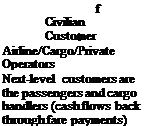Military Aircraft and Its Component Configurations
This extended section of the book can be found on the Web at www. cambridge .org/Kundu and depicts typical military aircraft components, with Figure 2.4 depicting an exploded view of an F16-type aircraft configuration.
Figure 2.4. Military aircraft configuration
Figure 2.5. A diagram of the General Dynamics (now Boeing) F16
1.6 Market Survey
In a free market economy, an industry cannot survive unless it grows; in a civil – market economy, governmental sustenance is only a temporary relief. The starting point to initiate a new aircraft design project is to establish the key drivers – that is, the requirements and objectives based on market, technical, certification, and organizational requirements. These key drivers are systematically analyzed and then documented by aircraft manufacturers (Chart 2.6).
In several volumes, documents that describe details of the next tier of design specifications (i. e., requirements) are issued to those organizations involved with
 |
![]()
Chart 2.6. The design drivers (in a free market economy, it faces competition)
a project. A market survey is one way to determine customer requirements – that is, user feedback guides the product. In parallel, the manufacturers incorporate the latest but proven technologies to improve design and stay ahead of the competition, always restricted by the financial viability of what the market can afford. Continual dialogue among manufacturers and operators results in the best design.
Military aircraft product development has a similar approach but requires modifications to Chart 2.6. Here, government is both the single customer and the regulatory body; therefore, competition is only among the bidding manufacturers. The market is replaced by the operational requirements arising from perceived threats from potential adversaries. Column 1 of Chart 2.6 becomes “operational drivers” that includes weapons management, counterintelligence, and so on. Hence, this section on the market survey is divided into civilian and military customers, as shown in Chart 2.7. Customer is a broad term that is defined in this book as given in the chart.
In the U. K. military, the Ministry of Defense (MoD), as the single customer, searches for a product and circulates a Request for Proposal (RFP) to the national infrastructure, where most manufacturing is run privately. It is similar in the United States using different terminology. The product search is a complex process – the MoD must know a potential adversary’s existing and future capabilities and administrate national research, design, and development (RD&D) infrastructures to be ready with discoveries and innovations to supersede an adversary’s capabilities.

 |
 |
Customer of Aircraft
Chart 2.7. Customers of aircraft manufacturer
The Air Staff Target (AST) is an elaborate aircraft specification as a customer requirement. A military project is of national interest and, in today’s practice, capable companies are invited to first produce a technology demonstrator as proof of concept. The loser in the competition is paid by the government for the demonstrator and learns about advanced technology for the next RFP or civilian design. Therefore, in a sense, there is no loser, and the nation hones its technical manpower.
Although it is used, the author does not think an RFP is appropriate terminology in civilian applications: Who is making the request? It is important for aircraft manufacturers to know the requirements of many operators and supply a product that meets the market’s demands in performance, cost, and time frame. Airline, cargo, and private operators are direct customers of aircraft manufacturers, which do not have direct contact with the next level of customers (i. e., passengers and cargo handlers) (see Chart 2.7). Airlines do their market surveys of passenger and freight requirements and relay the information to manufacturers. The surveys often are established by extensive studies of target-city pairs, current market coverage, growth trends, and passenger input. Inherent in the feedback are diverse requirements that must be coalesced into a marketable product. A major order from a single operator could start a project, but manufacturers must cater to many operators to enlarge and stabilize their market share. The civilian market is searched through a multitude of queries to various operators (i. e., airlines), both nationally and internationally. In civil aviation, the development of the national infrastructure must be coordinated with aircraft manufacturers and operators to ensure national growth. Airlines generate revenue by carrying passengers and freight, which provide the cash flow that supports the maintenance and development of the civil aviation infrastructure. Cargo generates important revenues for airlines and airports, and the market for it should not be underestimated – even if it means modifying older airplanes. Manufacturers and operators are in continual contact to develop product lines with new and/or modified aircraft. Aircraft manufacturers must harmonize the diversity in requirements such that management decides to undertake a conceptual study to obtain the go-ahead. There is nothing comparable to the process taken by the MoD to initiate an RFP with a single customer demand.
The private or executive aircraft market is driven by operators that are closely connected to business interests and cover a wide spectrum of types, varying from four passengers to specially modified midsized jets.
Military aircraft utilization in peacetime is approximately 7,500 hours, about one-tenth that of commercial transport aircraft (i. e., « 75,000 hours) in its lifespan. Annual peacetime military aircraft utilization is low (i. e.,« 600 hours) compared to annual civil aircraft utilization, which can exceed 3,000 hours.











